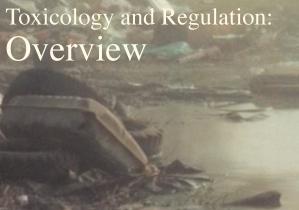Community |
||
Environmental |
||
Occupational |
||
Superfund Listings and Delistings: recent sites added for superfund remediation, based on threat to human health; those cleaned-up sites that have been delisted. |
||
TLV, TWA, REL, PEL, STEL, Ceiling Limits, EEL, STPL, SPEL, CEL, IDLH, ERPG, LOAEL, NOAEL, TD50, LD50. What these standards mean, how they are determined and how they are used; comparison between standards--how safety and hazard levels vary from one standard to another for same chemical. |
||
Agencies and the regulations that control some aspect of chemical exposure--in water, air, food, hazardous waste sites, soil, consumer goods, community or industrial settings. A guide and map as to who does what and how the different agencies and regulations coordinate, overlap or contradict one another. |
||

Regulation of chemical exposures integrates the findings of toxicology with risk assessment, statistics, epidemiology and risk benefit analysis. It influences and is influenced by the law and legal setting. It doesn't simply set standards but also reporting requirements, which is an enormous resource for information about chemicals and their release into the environment. For example, The Toxic Release Inventory (TRI) requires all companies to report any releases from a list of approximately 300 chemicals--amounts and location. In this way anyone can find out what if any chemicals were released into their community and the amounts, and the state of chemicals when released (solid, liquid, gas), and status of release.
Standards are set for all media (air, water, soil, food), for both acute and chronic exposures, and for different settings, including workplace, the environment and the community.
Without understanding the purpose and basis of each set of standards,they can be improperly applied or interpreted as to 'safety' or 'danger' levels. This section identifies and defines the myriad regulatory standards--national and international--the logic and data source for each set, and explains their purpose and limitations of use. This includes the use of animal versus human data, margins of error, safety factors, and the decision-making process.
Mercury hotspots?
Exposure Assessment, Analysis
Will changes to the Clean Air Act create mercury hotspots? Trading emission credits was based on successful program with carbon dioxide, a gas, which moves long distances from the source and is greatly diluted. But will this program work for a heavy metal, highly toxic which tends to accumulate near the source, creating potentional hotspots? Basis for this regulatory change.
See also Clinical effects, linkage to autism Toxicology & Medicine, News ]
Fine particulate matter (< 2.5 um): April 2005 EPA-designated non attainment areas
Exposure Assessment, Analysis
EPA's new focus on enforcing air quality standards for the 2.5 um criteria air pollutant, which plays major role in childhood respiratory problems and those with pre existing respiratory problems. What attainment will prevent. Household and community activities continue to contribute to this problem [Toxicology and the Home ].
See also: Chemical characteristics and mechanism of action fine and ultrafine PM, and relation to heart and respiratory disease [Science of Toxicology, In Brief, Toxicology & Medicine: Spotlight, In Brief, References].
Regulation

New EPA Guidelines for Carcinogen Risk Assessment of Children and Early Life Exposure
Hazard Assessment
First revision of guidelines for cancer risk assessment since 1986, and with first time guidelines that recognize unique susceptibility and risk of childhood and infant exposures to cancer-causing agents [ http://cfpub.epa.gov/ncea/cfm/recordisplay.cfm?deid=116283 ].
Lawsuit against American Conference of Governmental Industrial Hygienists (ACGIH)
Analysis
Dismissed on 3 of 4 counts in Federal Court: implications for responsibilities and free speech of advisory groups under Federal Advisory Committee Act (FACA) and Administrative Procedures Act (APC) manufacturer challenge to revision of TLVs that it claims will hurt business.

Endocrine Disrupting Chemicals: Implications for setting threshold values for 'safe' exposure to toxics. How these levels are set; types of toxicity testing used. Role of LD50 [lethal dose 50%], LOAEL [Lowest Observed Adverse Effect Level], and short term toxicity testing. Are these adequate with more sensitive measurements of toxicity and recent findings?
Mold, Moisture & Remediation: ACGIH Workshop, September 19-22, 2005, Cincinnati, Ohio
Air Quality Index for Particle Pollution: general categories and risks to sensitive sub populations; real time index: http://epa.gov/airnow
EPA Guidelines for Carcinogen Risk Assessment and Supplemental Guidance for Assessing Susceptibility from Early-Life Exposure to Carcinogens. http://www.epa.gov/cancerguidelines
FDA-EPA Advisory on Mercury and Fish Consumption: Why FDA/EPA maintained different standards for so long, the scientific basis, and what they have agreed to in joint advisory: what this joint statement says and doesn't say, and what it means and (doesn't mean). Distinctions between policy and science.
Material Safety Data Sheets (MSDS) and the information they are required to provide: how complete, how accurate,how scientific? Coordination with warning information of the Consumer Product Safety Commission (CPSC). Retailer's responsibilities and what the consumer is supposed to follow.
Exposure assessment and air modeling: EPA-approved air models; what they are approved to do and what they cannot do. Scientific basis for air models in acute chemical releases--error rates and general acceptance in the peer-reviewed scientific literature. Do they stand up to the Daubert?
American Conference of Governmental Industrial Hygienists (ACGIH) and its Threshhold Limit Value (TLV): use by governments around the world, how TLVs are determined--science versus cost benefit analysis--and limitations in 'safety' analysis. Uses and misuses in hazard